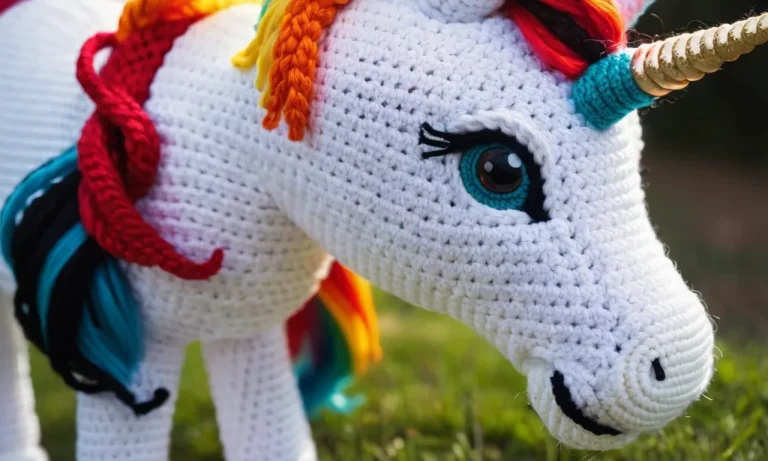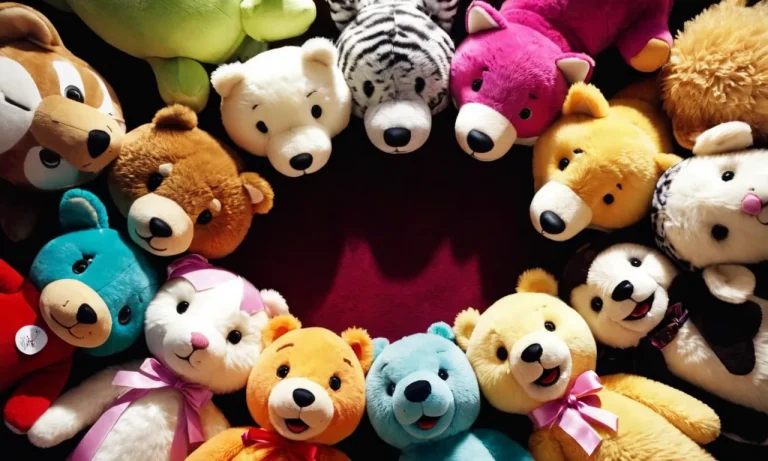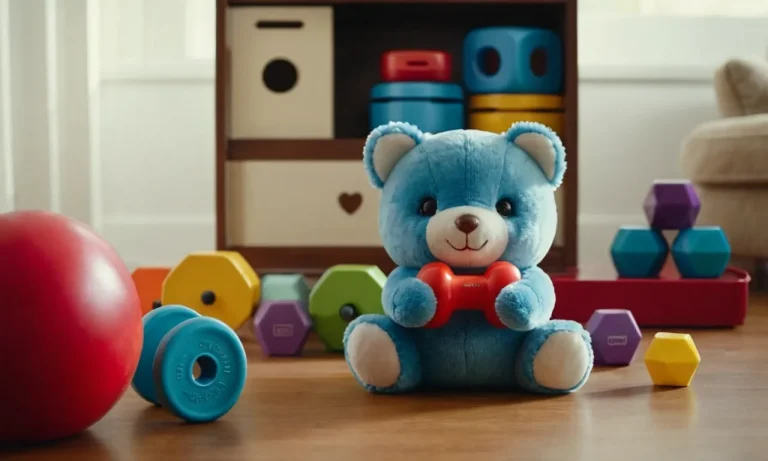As a parent, you likely want to know at what age you can introduce comfort objects like stuffed animals into your baby’s crib. If you’re short on time, here’s the quick answer: most experts agree that stuffed animals are safe for babies over 12 months old when loose bedding risks have passed.
In this comprehensive guide, we’ll cover when and why it’s safe for your little one to cuddle a stuffed friend at night. We’ll go over suffocation risks, how to choose an appropriate stuffed animal, using loveys to soothe separation anxiety, and more tips to help your baby sleep safely and soundly.
Suffocation Risks of Stuffed Animals
Under 12 Months
Stuffed animals pose a suffocation risk for babies under 12 months old. At this age, babies explore objects by putting them in their mouths, which can block their airway if the object gets lodged in their throat (Healthy Children).
According to the American Academy of Pediatrics (AAP), soft bedding like stuffed animals should be kept out of a baby’s sleep area. This recommendation is part of the AAP’s safe sleep guidelines, which aim to reduce the risk of sudden infant death syndrome (SIDS) and other sleep-related deaths (AAP).
Specifically, the AAP recommends the following:
- Place baby on their back to sleep, not their side or stomach.
- Use a firm sleep surface without soft bedding, blankets, pillows, bumper pads, or stuffed animals.
- Do not use a sleep positioner device.
- Keep baby’s sleep area close to but separate from where parents sleep.
Following these guidelines is crucial in the first year to minimize suffocation, entrapment, and overheating risks. Parents can monitor baby with a video monitor if needed but should keep the crib clear of clutter.
Over 12 Months
The risk of suffocation drops significantly after 12 months when baby is less likely to put objects in their mouth. However, some safety precautions are still needed.
The AAP recommends keeping soft bedding, including stuffed toys, away from baby’s sleep area until age 1. After this milestone, a small familiar stuffed animal may be introduced for comfort. Choose a lightweight, flat stuffed toy no bigger than baby’s chest area.
Here are some stuffed animal safety tips for ages 1-2:
- Attach stuffed animals to cribs/playpens with clear straps or Velcro.
- Only allow stuffed animals made with flame-retardant material.
- Select ones labeled non-toxic that can be surface washed.
- Trim loose threads, buttons, bows etc. that could detach.
- Check frequently for wear/tear and discard when unsafe.
With some precautions, stuffed buddies can safely give comfort and joy once baby enters toddlerhood! But until age 1, bare is best when it comes to bedding according to pediatricians.
Choosing an Appropriate Stuffed Animal
When choosing a stuffed animal for a baby, there are a few key factors parents should consider for safety and appropriateness, including the age of the baby, material and construction of the toy, size, and more.
With some general guidelines in mind, parents can pick out cute plush pals that babies will love both for play and comfort.
Age Guidelines
Most child development experts agree that the best age to introduce a stuffed animal to a baby is around 3-6 months or when a baby can hold objects and bring them to their mouth. At this age, stuffed toys make great tethers for a baby to grab, hold, and start interacting with.
Before 3 months, experts caution against leaving stuffed animals or any soft bedding in a baby’s sleep area because of the potential risk of suffocation. So if wanting to place a plush toy to decorate a crib, make sure baby isn’t yet rolling over or mobile enough to reach and mouth it.
Material Safety
When shopping for a stuffed toy, check that it is made of safe, baby-friendly materials. Look for toys marked as meeting FD&C safety standards for materials and dyes used. Organic materials like cotton or wool that meet global safety standards are ideal.
Avoid old or handmade stuffed animals that may contain unsafe fillers, dyes, or loose parts.
At minimum, make sure any stuffed animal is:
- Flame retardant
- Has securely-attached eyes and nose pieces so they cannot be pulled off and choke a baby
- Contains hypoallergenic stuffing such as polyester fiber
- Is machine-washable
Appropriate Size & Shape
Choose a stuffed toy that is lightweight and easy for little hands to pick up and hug. Large teddy bears may seem cute but are often too big, heavy, and awkward for an infant to manipulate and play with.
Look for a small- or medium-sized stuffed animal between 5 to 10 inches long. At this size, babies can easily grip and maneuver stuffed toys on their own once they reach 3-6 months. Too large or too small toys will be frustrating for a young baby’s developing motor skills.
In terms of shape, soft stuffed balls, loveys, or floppy-limbed animals allow babies to more easily grasp, pick up, and play with the toys. Avoid picking stiff, rigid shapes or toys babies may find hard to snuggle and play with.
| Age | Size Recommendation |
|---|---|
| Newborn | Avoid loose bedding and stuffed toys |
| 3 months+ | 5 to 10 inches long |
With some general age, safety, and appropriateness guidelines in mind, most babies take quickly to snuggling a soft stuffed companion both in the crib and playtime. Just be sure to pick developmentally-appropriate plush pals and frequently machine wash the toys to keep them safe and hygienic as baby mouths and drools on them while teething and playing.
Using a Lovey for Separation Anxiety
A “lovey” or comfort object can be an extremely helpful tool for easing a baby’s separation anxiety. Separation anxiety generally starts between 6-18 months old when babies become more aware of the world around them. They realize when a caregiver leaves, which can cause great distress.
Having a special stuffed animal or blanket to cling to can provide huge comfort. Here’s how a lovey can help.
What is a Lovey?
A lovey is any soft, cuddly object like a stuffed animal or blanket that a baby bonds with. It becomes something familiar and comforting to have when challenged with new situations. Loveys often develop special meaning because they absorb the scent of the caregiver.
Babies associate mom and dad’s smell with safety. This makes a lovey the perfect transitional object when away from parents.
Choosing a Lovey
When can you introduce a lovey? Many experts say around 3-6 months old is a good time. This gives plenty of time for attachment before separation anxiety sets in. Stuffed animals with simple faces rather than lots of hard plastic pieces tend to work best.
Make sure any loose parts meet safety standards for babies. It’s also wise to pick a lovey that can withstand the washing machine!
Don’t worry if your baby doesn’t take to a lovey right away. Sometimes it takes a few tries. Make it easily accessible in the crib so they associate bedtime with their new friend. Take it along for car rides and trips to the store.
The more places that lovey goes, the more likely they’ll turn to it for comfort when you’re not physically present.
Using a Lovey to Soothe Separation Anxiety
Once a baby has bonded with their special lovey, it can work wonders to ease the pains of separation! Here are some tips for using a lovey when you leave your little one:
- Let them hold and snuggle the lovey as you put them down for naps or bedtime when you’ll be leaving the room.
- Spritz a little of your perfume or aftershave on the lovey so it smells like you.
- Put the lovey in your shirt next to your skin so it absorbs your scent before giving it to baby.
- Pack the lovey any time you’ll be away from home like visiting grandparents or a sitter comes over.
- Remind older babies “mommy will be back after your nap with bunny!” so they have a reassuring image.
Having that familiar, mom-scented friend can give anxious babies a little piece of you when you have to be apart. While some babies grow out of needing a lovey as they get older, others enjoy keeping their special stuffed pal well into childhood.
Weaning Off the Lovey
If your child is older but still extremely attached to their lovey, you may worry about how they’ll manage without it someday. There are gentle, gradual ways to encourage independence when the time feels right.
This often happens naturally around ages 3-4 but could be later if attachment is very strong.
You can try short outings without the lovey first before longer separation. Put it in a safe spot and let them know you’ll return to find bunny waiting there. Having a comfort kit for school with a photo of lovey can also help ease the transition.
Reassure them verbally rather than relying solely on the object for self-soothing. Your unconditional love and support will give them confidence.
The key is not to force separation before your child feels ready. Eventually they will gain enough security in themselves and their surroundings to fend off anxious feelings. Thanks to the roots put down with their early lovey friend, they’ll be able to branch out while carrying that comfort with them in their heart.
Tips for Safe Sleep with a Stuffed Animal
Stuffed animals can make great comfort items for little ones, but there are some safety considerations when it comes to sleep. Here are tips for making sure your baby sleeps safely with their favorite stuffed friend:
Wait Until 12 Months
The American Academy of Pediatrics recommends waiting until your baby is 12 months or older before adding any stuffed animals or other soft bedding to the crib. Babies younger than a year are at higher risk for SIDS (sudden infant death syndrome).
Choose a Small Stuffed Animal
When your baby reaches that one year mark, opt for a small, lightweight stuffed animal. Large or heavy stuffed animals could end up covering your baby’s face or making them too warm.
Keep It Away from Baby’s Face
Be sure to position the stuffed animal away from baby’s face during sleep. You want to prevent any risk of blocking their nose or mouth.
Don’t Use Stuffed Animals with Young Infants
Stuffed toys and bedding should be kept out of sleep spaces for newborns and young infants up to 12 months. At this age, babies should sleep on their backs on a firm, flat surface without any soft bedding or toys. Following safe sleep guidelines reduces the risk of SIDS.
Regularly Clean the Stuffed Animal
To prevent germs from building up, wash your child’s stuffed animal regularly according to the manufacturer’s instructions. You may also spot clean in between washes if the stuffed animal becomes dirty or contaminated with saliva or other fluids.
Use as a Transitional Object
A favorite stuffed buddy can be a great transitional object to comfort your toddler when they move from a crib to a bed. Just be sure it’s positioned safely away from little faces during sleep.
Supervise Nap Time
When your toddler starts napping with stuffed animals, be sure to check on them frequently. Make sure the toy doesn’t end up covering their face or making them too warm under blankets.
Choose Appropriate Toys
When selecting stuffed animals, look for ones that are child-safe with secure eyes, nose and other attachments. Check labels for ages 12 months+ and remind older kids not to give their younger siblings toys with loose parts.
Following some basic safety precautions allows your little one to enjoy their special snuggly friend at bedtime. Sweet dreams!
Conclusion
While stuffed animals pose a risk for babies under 12 months, they can become a beloved source of comfort once your little one turns 1. Choose a simple stuffed friend without any loose parts, practice safe sleep guidelines, and enjoy watching your baby snuggle their new lovey at bedtime!







